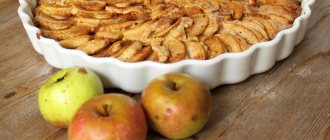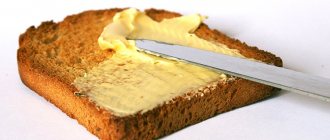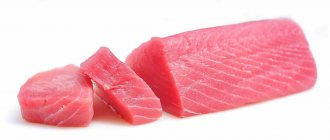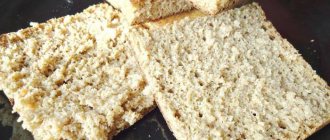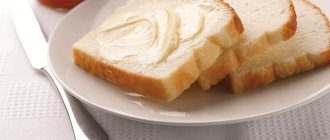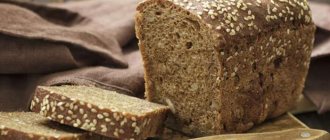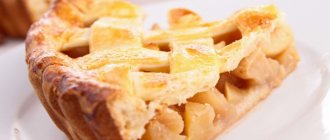Whole grain bread is easy to recognize in a store among other types of bread by its appetizing appearance, because the product is decorated with numerous whole grains. The calorie content of grain bread depends on its composition and the ratio of auxiliary components. Most often, this type of baked goods is made from corn, barley, rice and other grains. You can often find grain mixes. Many manufacturers add pumpkin to this bread and sprinkle seeds on top.
- Calorie content of whole grain bread
- Nutritional value of whole grain bread
- Composition of grain bread
- Useful properties of grain bread
- Harmful properties of the product
What is whole grain bread?
Whole grain bread is bread made from partially or fully milled flour from whole or nearly whole wheat grains.
Unlike the usual white bread, whole grain bread is baked from flour based on whole grains, containing, in addition to endosperm, germ and bran. Bran is rich in fiber, some minerals and antioxidants, and the germ is the main source of vitamins from cereal plants. This is why whole grain bread is considered healthier than white bread.
Not only wheat can be used as a grain for making whole grain flour. Manufacturers often add millet, corn, rye and oats, as well as some other grains.
Externally, the product is not very different from ordinary bread; it may have a darker color and a rougher structure.
However, be sure to read the product label to determine its true composition. The presence of a topping of seeds, poppy seeds or caraway seeds, or bran does not say anything about the flour that is used as the basis for making bread. In this way, manufacturers only artificially add naturalness to their product.
Whole grain bread is made from whole or nearly whole grains, which are rich in nutrients. This product is much healthier.
What is enriched bread?
You may see the word "enriched" on commercially prepared bread sold at the grocery store. Fortified foods have nutrients added back during processing, most often removed during the manufacturing process. Fortified foods are usually made from refined grains, or grains that have been processed so that the whole grain is no longer in tact.
Given the calorie content of whole grain bread and the fact that it typically contains more nutrients, including fiber, it has become a consistent choice for those trying to eat a healthy diet. While a recent systematic study found that eating fiber foods is less likely to curb hunger and reduce overall food intake than is often claimed, dietary fiber intake is still associated with lower body weight.
To tell if bread is made from whole grains, don't rely on the front of the bread package to determine whether the bread is made from whole grains: many times food manufacturers use words like "multigrain" to make their food healthier. Instead, check the ingredient list. Whole grains (such as whole wheat, wheat, oats) will be listed as one of the first ingredients. The Whole Grains Council provides a comprehensive guide to deciphering labels to find whole grain products.
When looking for an answer to the question of what kind of bread you can eat on a healthy diet, you should not completely exclude the option of white bread - it is not necessarily harmful to your diet, despite the fact that it provides calories (energy) without as much food as whole grain bread.
If you're trying to cut back on your bread intake, there are a few bread alternatives you can try. For example, did you know that you can make a sandwich using cucumber instead of bread? And many "healthy" eaters wrap their healthy beef or turkey burger in lettuce rather than a bun.
Composition and calorie content
The ratio of nutrients directly depends on the type of grain used. The “average” whole grain bread contains:
- alimentary fiber;
- vitamins (A, C, group B);
- minerals (manganese, phosphorus, zinc, iron, copper, magnesium);
- proteins;
- antioxidants (phytic and ferulic acids, lignans).
Fiber supports digestion, proteins serve as important building materials, and antioxidant compounds prevent the development of malignant tumors and some chronic diseases.
Whole grain bread has a low calorie content (247 calories per 100 grams) and an average glycemic index (about 40-50). For comparison: the glycemic index of white bread is 70.
The product contains valuable biologically active substances, has low energy value and is not dangerous for people with diabetes.
Useful properties of grain bread
The content of B vitamins, vitamin E, as well as magnesium and potassium makes the product beneficial for the cardiovascular system. The product also has a positive effect on the health of the central nervous system.
Despite the rather high calorie content, the product is useful even for obesity and diabetes. The fact is that when making bread from refined flour, most of the nutrients are lost, and carbohydrates and calories enter the body. The beneficial properties of whole grain bread for the human body lie precisely in the preservation of the grain shell, rich in useful elements, in the product. How to lose weight by eating high-calorie foods? It is necessary to replace ordinary bread made from refined flour with a whole grain product. Of course, you should consume it without fanaticism, a maximum of three pieces per day.
The high content of fiber in the product affects the functioning of the gastrointestinal tract. Fiber normalizes the functioning of the stomach, cleanses the walls of the digestive system, and frees the body from waste and toxins. It is thanks to fiber that you can lose weight by including whole grain bread in your diet. Coarse dietary fiber fills the stomach, giving a feeling of fullness.
Contraindications
Whole grain bread is not a harmless product. In some cases it can be harmful to health. The main contraindications are:
- Gluten intolerance. Whole rye, wheat, barley are sources of protein (gluten), which about 1-5% of the world's population cannot tolerate. Such people, when taking whole grain products, develop a lot of unpleasant symptoms: from fatigue and joint pain to severe dyspeptic disorders.
- Irritable bowel syndrome. Some grains (such as wheat) contain short-chain fatty acids, which increase the symptoms of this disease.
When taking the product, chronic diseases of the stomach and duodenum (chronic gastritis or gastroduodenitis, peptic ulcer) may worsen. Whole grain bread can cause microdamage to the mucous membranes and also increase the acidity of gastric juice.
Bread, in the absence of the contraindications described above, can be safely consumed during pregnancy and breastfeeding.
Including whole grain bread in the diet (especially on a regular basis) requires careful assessment of your health status in order to eliminate risks.
How is whole grain bread different from others?
Whole grain bread contains unrefined flour, which means flour that has not undergone additional processing and has retained its shells. They contain useful components for the human body: dietary fiber, vitamins, fiber and minerals. White or premium flour does not contain all these components. Which makes it simply empty and useless for humans. Whole grain flour can be obtained from any grain, however, rye is considered the most delicious type for making bread. Whole wheat is not suitable as it has a more bitter taste.
Rye flour is coarser and has a darker shade, which cannot be said about wallpaper flour. Bread made from whole grain rye flour is heavier and lumpy, and its color is grey-brown. It stays fresh and moist for a long time. This bread should not crumble; small sticky crumbs may remain on the knife. When choosing whole grain bread, you should be especially careful. Since some manufacturers pass off colored bread made from refined grains as whole grain bread. Be sure to read about the composition of whole grain bread on the product packaging.
How to choose it in the store?
Purchasing truly healthy bread in a store is not an easy task. Let's consider the key subtleties of choice:
- Whole grain flour content. Many modern manufacturers add only a small amount of whole grain flour and immediately change the name. Its optimal content is 99-100%.
- Secondary products. Quality bread should not contain thickeners, modified starch, azodicarbonamide, calcium propionate, sodium benzoate, soy flour and soy protein isolate. The presence of natural preservatives (for example, ascorbic acid) is allowed.
- Amount of fiber. 100 grams of bread should contain at least 8-12 grams of dietary fiber. Fiber should be natural (from whole grains), and not from other sources, such as inulin.
- Proportion of sugar and salt. An abundance of sugar makes the product tastier, but reduces biological potential; excess salt can adversely affect cardiovascular health. The optimal content of sodium chloride and sugar in 100 grams of bread is 200 mg and 2 grams, respectively.
- Appearance. Whole grain bread is always sealed. The cuts or crust often contain whole grains. The color is determined by the composition and can be anything.
- Consistency . Whole grain bread is dense to the touch and a little rough. A soft and fluffy product (with adequate composition) always costs 2-3 times more.
Simple tips will help you choose truly natural bread that is healthy.
How many calories are in grain bread
The nutritional value of whole grain bread varies depending on the dominant crop type. Features of bread production: instead of refining flour produced by crushing, manufacturers bake bread from whole grains. In this way, it is possible to preserve the full composition of microelements, some of which are destroyed during heat treatment. At the same time, the variety of vitamins remains large. The benefits and harms of whole grain bread stem from the chemical composition of the product. And he is incredibly rich in various vitamins, micro- and macroelements, and fiber.
Grain bread consists of:
- grains (if flour is used, then from grain flour);
- milk;
- water;
- salt.
Wheat flour, yeast, honey, butter, sugar, and vegetables are often added.
The calorie content of multigrain bread is difficult to change without knowing the proportions, but in general the average is 230 kcal - higher than other types of bread.
The calorie content of whole grain bread is on average 230 kcal. With the addition of grains per 100 grams of product there will be an increase of 20 kcal.
100 grams contain 9.6 grams of protein, which corresponds to 35 kilocalories. There is relatively little fat in grain bread - 1.4 grams, which corresponds to 13 calories. Carbohydrates 45 grams (180 kilocalories). 80% of the product is carbohydrates, but despite this, the composition of grain bread has high nutritional value.
The calorie content of fitness whole grain bread can be at least 200 kcal per 100 grams due to the addition of pumpkin or other auxiliary vegetable components considered a dietary product.
How to do it at home?
Consider a simple recipe for making whole grain bread. It cooks quickly and does not require rare ingredients.
Required:
- 400 grams of whole grain flour (any);
- 20 grams of dry yeast;
- 300 ml warm water;
- 1 tbsp. l. salt;
- 1 tsp. Sahara;
- to taste – sesame seeds, rosemary, Provençal herbs;
- 30-40 grams of butter (for greasing the mold).
Preparation:
- Gently and consistently mix all ingredients until smooth.
- Pour water in a thin stream, constantly kneading the dough. It should turn out loose.
- Place the mixture in a container and cover with a towel or cling film. Let stand for 1 hour in a warm place.
- Prepare a baking dish. It should be evenly greased with butter.
- Transfer the dough into the mold. Sprinkle with sesame seeds.
- Place in an oven preheated to 200°C for 35-40 minutes. After the cooking cycle has finished, allow to cool in the oven for about 30 minutes. It is not recommended to open the door. Natural bread is ready.
Instead of warm water, you can use kefir or fermented baked milk.
The resulting product is light and soft. Pairs perfectly with any vegetables and herbs.
Making your own whole grain bread is easy. The main thing is to choose high-quality and natural ingredients.
Recipe for grain bread "Hercules"
Hercules grain bread is popular due to its taste. In addition, it is relatively easy to prepare.
So, you will need: milk (one glass); oatmeal flakes (one glass); honey (one and a half tablespoons); whole grain rye flour (two cups); butter (1 tablespoon); salt (half a teaspoon); slaked soda (2 tsp), bran (2 tbsp). If you wish, you can also diversify the taste of future baked goods by adding spices and sunflower seeds.
Mash the honey and butter as thoroughly as possible. Pour in the milk and stir until completely dissolved. Then you can add a glass of flour, baking powder and oatmeal. At this stage we also add seasonings if you want to give the bread a more savory taste.
Mix the ingredients thoroughly. Start kneading the dough, while gradually adding the remaining flour. Add bran. Knead the dough until you can form a round loaf with your hands.
Place the bread on a baking sheet and place in the oven preheated to 220°C. You can first sprinkle rolled oats on top.
Bake for about half an hour. Before removing the bread from the oven, test it for doneness with a match.
Admission Tips
It is equally important to use and store bread correctly. Let's dwell on the main subtleties:
- When is the best time to eat? It is better not to take whole grain bread on an empty stomach or at night. This can negatively impact your stomach health and disrupt your sleep. It is recommended to take the product in the middle of the day.
- What to combine with. Bread goes well with vegetables, herbs (lettuce, cilantro), as well as lean meat.
- As much as possible per day. It is not recommended to consume more than 200-300 grams of product per day. Excess intake (if the daily energy value is exceeded) can disrupt intestinal function and lead to obesity.
- How to store. The bread will retain its properties better when tightly wrapped in cooking paper at room temperature (up to 7-10 days) or in an airtight container in the refrigerator (up to 5-10 days).
Proper consumption of whole grain bread will allow you to enjoy the exquisite taste and get exceptional benefits from it.


